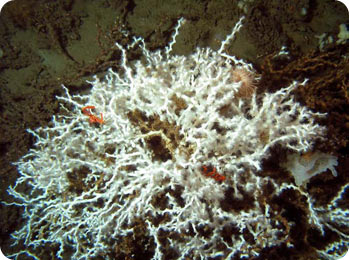 A thicket of the coral species Lophelia pertusa observed at 1,640 feet in the Gulf of Mexico. Credit: NOAA/Department of Commerce. Image courtesy of Chuck Fisher, Penn State University, NOAA-OER.
A thicket of the coral species Lophelia pertusa observed at 1,640 feet in the Gulf of Mexico. Credit: NOAA/Department of Commerce. Image courtesy of Chuck Fisher, Penn State University, NOAA-OER.Cold-water corals are just that − coral species found in cold, deep water throughout the globe, on continental
shelves, ocean banks and seamounts. Living at depths of more than 3,000 feet in temperatures of 39 to 55 degrees Farenheit, cold-water corals form small patches or thickets as well as larger reef structures.
At such depths, cold-water corals are missing one ingredient that is essential to their shallow-water relatives: sunlight. Corals of the familiar warm-water reefs depend on symbiotic algae, which use photosynthesis to provide nutrients for the corals. Cold-water corals fend for themselves through suspension feeding, catching tiny organisms and organic matter from the water. Many species that use this feeding technique have branching, treelike forms.
Because of their remote locations, cold-water corals historically have been a challenge to study. Thanks to modern advances, like manned submersibles and remotecontrolled underwater vehicles, scientists are gaining
knowledge about cold-water corals and their relationships with other marine species. Cold-water coral aggregations provide habitat for myriad creatures, including many commercially important food fish. This also puts the corals in harm’s way. Trawlers can damage coral communities when they drag their heavy fishing gear along the seafloor.
Scientists hope that by learning more about the role of cold-water corals in the marine ecosystem, they can make the case for protecting these fragile, fascinating habitats.


